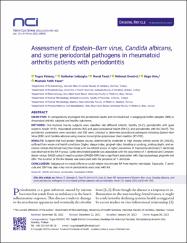Assessment of Epstein-Barr virus, Candida albicans, and some periodontal pathogens in rheumatoid arthritis patients with periodontitis
Künye
Paksoy, T., Ustaoglu, G., Tasci, M., Demirci, M., Unlu, O., & Yasar, M. F. (2023). Assessment of Epstein-Barr virus, Candida albicans, and some periodontal pathogens in rheumatoid arthritis patients with periodontitis. Northern clinics of Istanbul, 10(4), 490–500. https://doi.org/10.14744/nci.2023.58998Özet
OBJECTIVE: To comparatively investigate the periodontal results and microbial load in subgingival biofilm samples (SBS) in rheumatoid arthritis subjects and healthy volunteers.METHODS: One hundred twenty subjects were classified into different cohorts: healthy (H-C); periodontitis with good systemic health (H-P); rheumatoid arthritis (RA) and good periodontal health (RA-C); and periodontitis with RA (RA-P). The periodontal parameters were recorded, and SBS were collected to determine periodontal pathogens including Epstein-Barr Virus (EBV) and Candida albicans using reverse transcription-polymerase chain reaction (RT-PCR). RESULTS: Subjects that had greater disease course, determined by moderate or high disease activity scores 28 (DAS28), suffered from worse oral health conditions (higher plaque index, gingival index, bleeding on probing, probing depth, and excessive clinical attachment loss) than those with low DAS28 scores. A higher prevalence of Treponema denticola (T. denticola) was observed in the RA-P group. Cyclic citrullinated peptide was associated with the occurrence of T. denticola and Campylo-bacter rectus. DAS28 using C-reactive protein (DAS28-CRP) had a significant association with Capnocytophaga gingivalis and EBV. The duration of the RA disease was associated with the presence of T. denticola.CONCLUSION: Subgingival microbial difference could reliably discriminate RA from healthy individuals. Especially, T. denti-cola and EBV may play a key role in periodontitis associated with RA.

















